Hydrogeological situation on 1 November 2023
In October, the water table levels went through a transitional phase. The heavy rainfall from mid-October onwards and the onset of vegetation dormancy finally signalled the start of the recharge: levels have risen in 41% of aquifers. However, the trends varied depending on intensity of the rainfall and the responsiveness of the aquifers.
The rainwater infiltration was insufficient to bring about any significant improvement in the state of the water tables. The situation remained similar to that in September: 65% of levels were below monthly averages in October (66% in September). Overall, the state of the aquifers varies according to the region. The levels remain below monthly averages over much of the country, particularly around the Mediterranean coast, along the Rhône-Saône corridor and in southern Alsace.
The trends in November will depend primarily on the cumulative rainfall. The heavy rainfall forecast for early November should enable the recharge to begin in all the aquifers and a general improvement in the situation should be observed. At the beginning of the recharge period, it is extremely important to give water reserves that are in a fragile state the time they need to recover in order to ensure their long-term sustainability. The situation needs to be particularly closely monitored in the aquifers which continue to show low to very low levels.
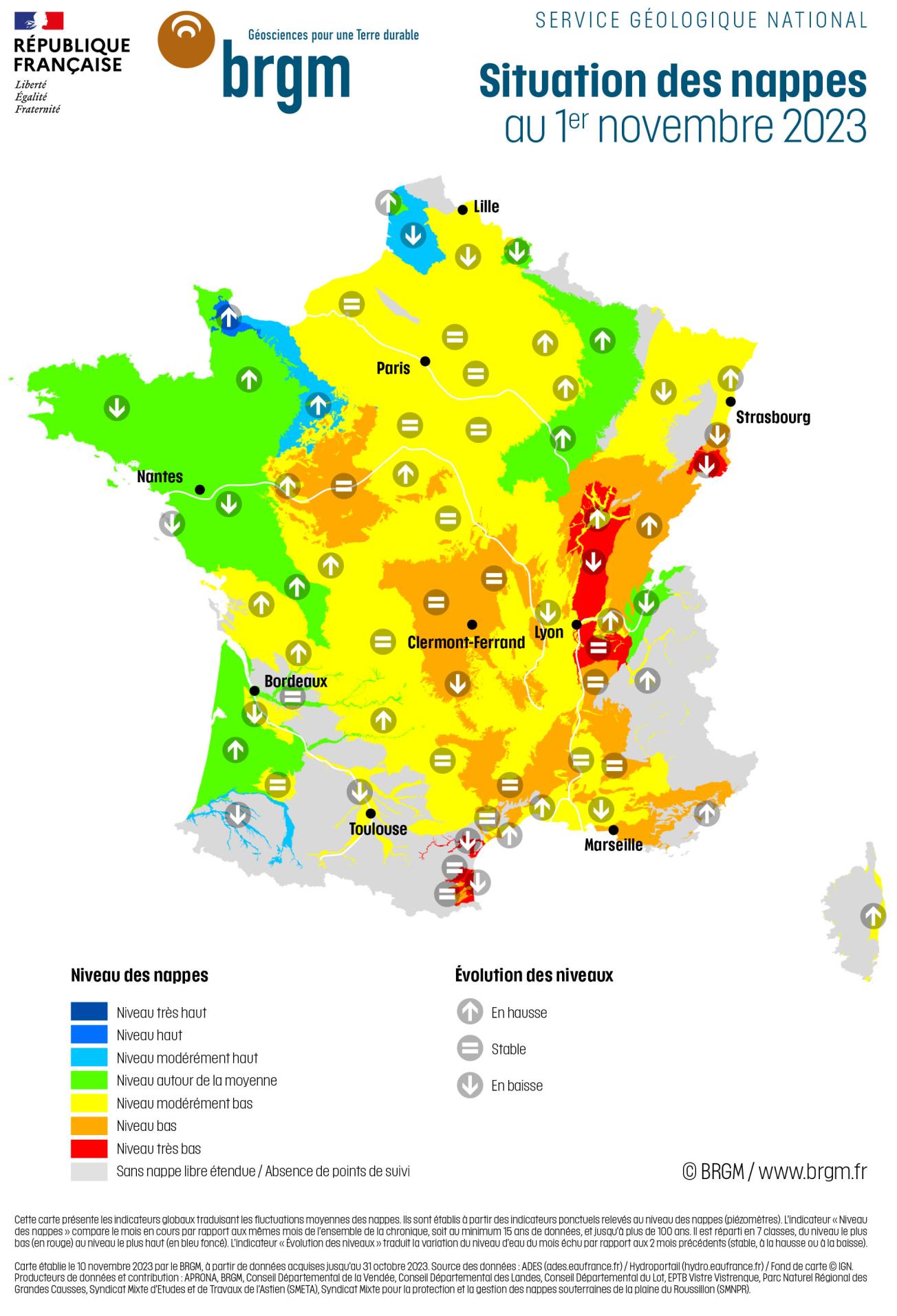
Map of aquifer levels in mainland France on 1 November 2023.
© BRGM
Groundwater trends
The 2022-2023 recharge period was insufficient over a large part of France. The rainfall in early spring and summer led to recharge episodes and, above all, helped sustain the groundwater levels in reactive aquifers and in areas that received a lot of rainfall. It also reduced the need for withdrawals from aquifers. In September, the groundwater depletion continued, due to insufficient rainfall and the fact that the vegetation remained active due to high temperatures.
In October 2023, the recharge period finally began. The trends were variable, with 41% of observation points showing increased levels, 29% remaining stable and 30% with decreasing levels (compared to 12%, 18% and 70% respectively in September).
October was a transitional period for the aquifers. The heavy rainfall and the onset of vegetation dormancy enabled the water to filter deep into the ground. This resulted in a reversal of trends in terms of groundwater levels. The 2023-2024 recharge period began a little later than usual, starting in mid-October due to the occurrence of significant episodes of rain. The groundwater levels rose in reactive aquifers in the areas that received a lot of rainfall, whereas the levels in inertial water tables and areas that received little rainfall started to stabilise or continued to fall.
Over a large part of northern France, the levels in reactive aquifers rose. Decreasing or stable levels were only observed in the basement aquifers of the Armorican Massif in Brittany, in the Pays-de-la Loire and in the Massif Central, where the rainfall infiltration was less significant. As regards the more inertial aquifers, the levels decreased or remained stable in the Artois region, the centre of the Paris Basin, the east of the Grand-Est region and in the Rhône-Saône corridor (except in the reactive alluvial aquifers). Here, the recharge period has started to set in slowly. This is due to the slow reaction times (inertia) of these aquifers, where rain that filters through the ground can take several weeks to reach the actual aquifers.
The situations were variable in the deep south and Corsica. Heavy rain fell in certain hilly areas on the plateaux, generally in the upstream parts of catchment basins. Consequently, the recharge began in the aquifers in these areas. The aquifers located downstream and connected to the rivers that run off from these basins also benefited from a recharge episode.
Comparison between 1 November 2022 and 1 November 2023
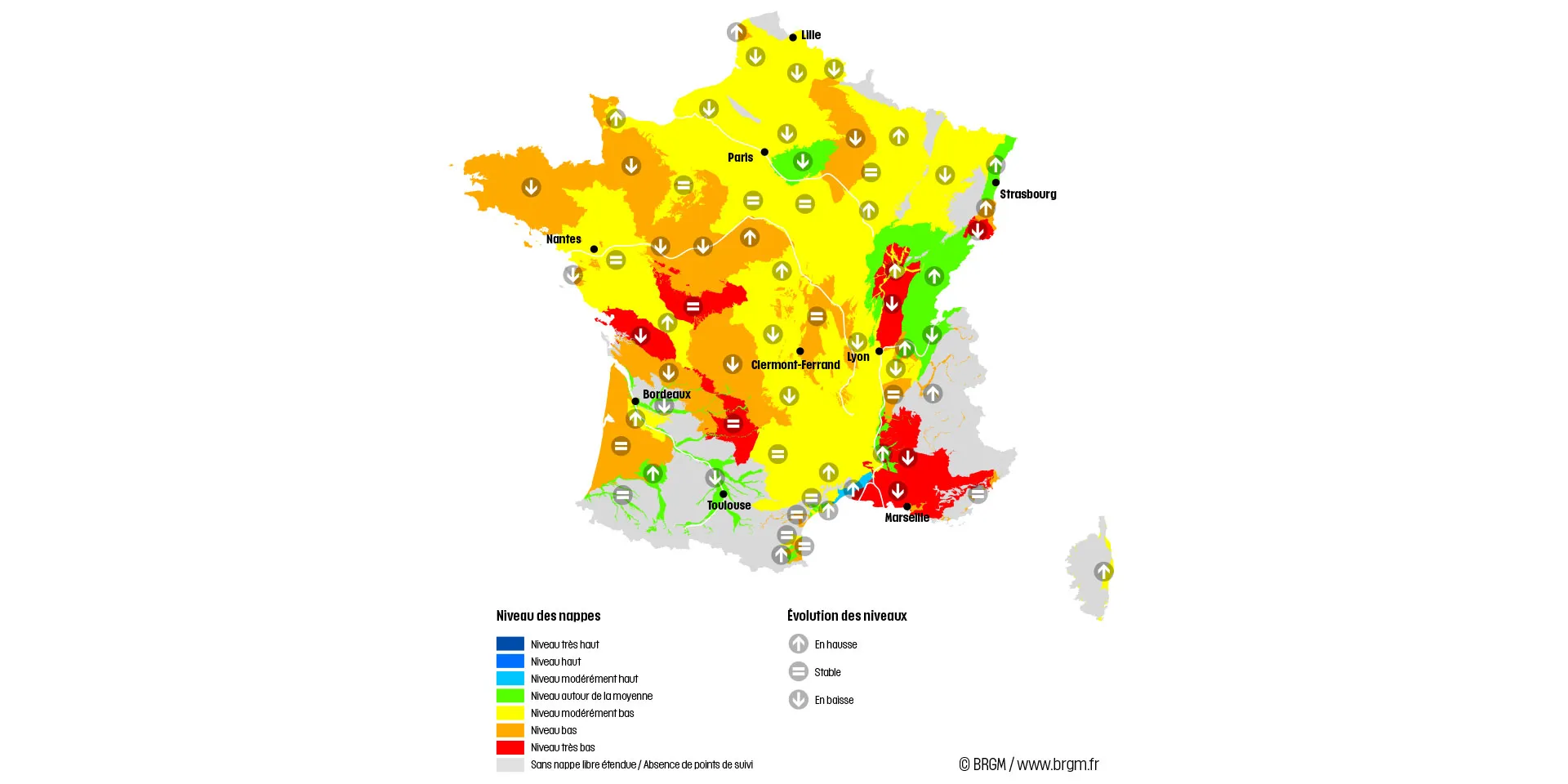
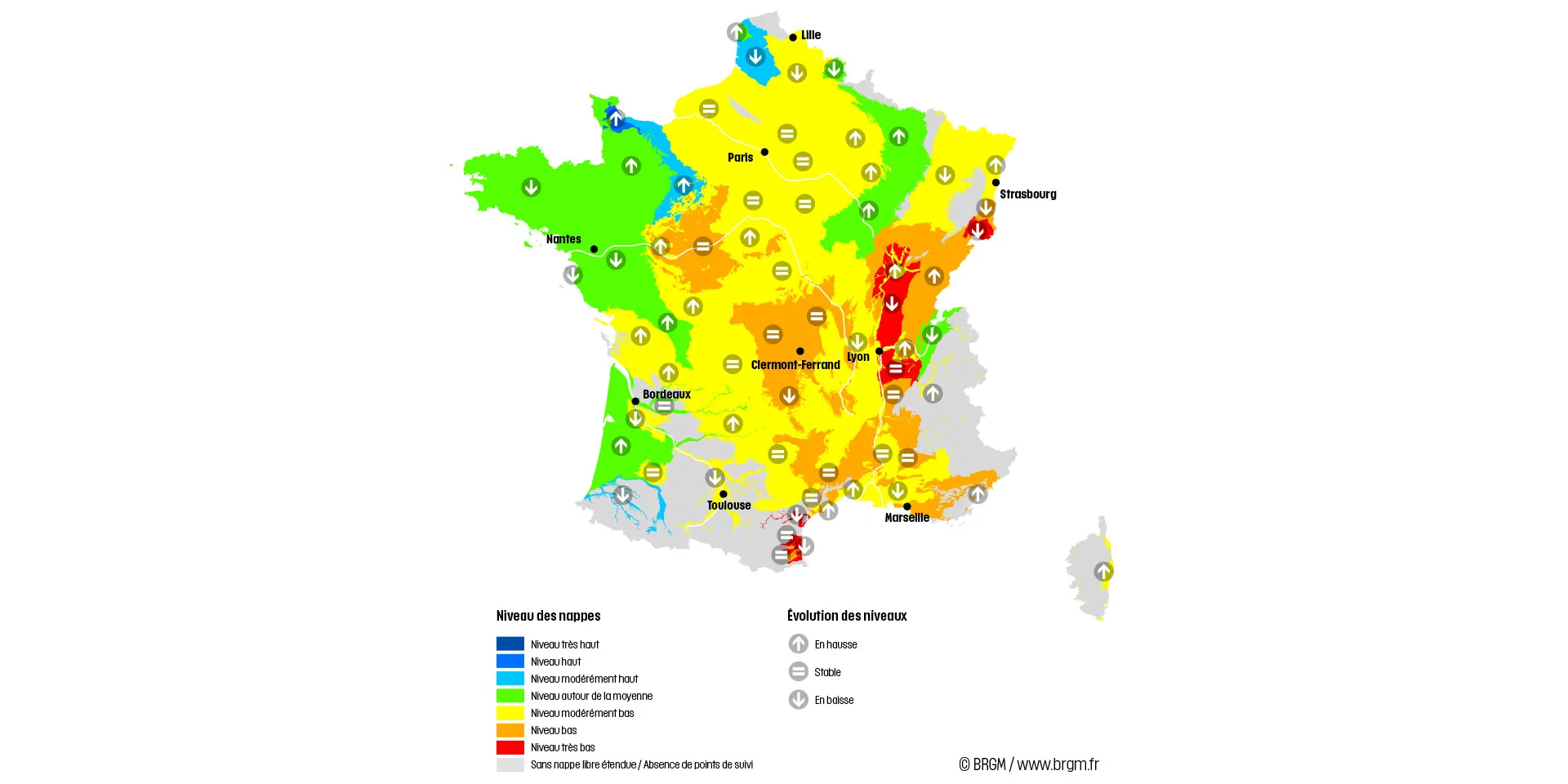
Map of France showing the state of the aquifers on 1 November 2022 (left) and 1 November 2023 (right).
© BRGM
The groundwater situation
The groundwater situation at the end of the 2022-2023 winter period was unsatisfactory. The spring and summer rainfall helped to maintain, and sometimes even improve, aquifer levels in the areas that received the most rain.
The rain that fell in the second half of October 2023 was insufficient to have a significant effect on the state of the aquifers. The overall situation in October therefore remained similar to that in September: The levels recorded in 65% of observation points were below monthly averages (66% in August) and 18% were very low (18% in August). That being said, the overall situation was more positive than that observed last year, in October 2022, when 75% of the levels recorded were below monthly averages. However, the differences in local situations were more marked in 2023 than in 2022.
The situation in October 2023 was variable, ranging from very low to high levels. The groundwater situation essentially depends on the cumulative rainfall over the spring and summer and its impact on the aquifers.
As regards the inertial aquifers, the levels were generally below monthly norms. The aquifer levels recorded in Artois, the Paris Basin, eastern Lorraine and Alsace were generally moderately low. The situation was less favourable in southern Alsace (which had low to very low levels) but better on the Artois coast (moderately high levels). The levels in the inertial aquifers in the Rhône-Saône corridor remain a concern, being low to very low. Only the aquifers in the Savoie foothills were above monthly averages.
The situation also remained variable as regards the reactive aquifers. The levels were satisfactory, from moderately low to moderately high, in the west, from the Hauts-de-France to Nouvelle Aquitaine. This is due to several recharge episodes during the spring and summer, which helped to improve their situation. Over the rest of the country, the levels in reactive aquifers remained moderately low to low. The Jurassic limestone aquifers in Lorraine and the Côte-des-Bars were exceptions to this trend, with levels close to normal due to episodes of rainfall in July and August. The situation continued to deteriorate around the Mediterranean coast, with worrying levels noted in the Roussillon and Corbières limestone aquifers and the alluvial aquifers in Aude. The rain that fell in September and October was still far from sufficient to offset the deficits accumulated since 2022.
Aquifers in good condition
Several aquifers were in good condition, with moderately-high to high levels in comparison to those recorded during October in previous years:
- The levels in the Cenomanian chalk marl aquifer on the Artois-Picardy coast remained moderately high, following the high-excess recharge of 2022-2023, supported by rainfall in the spring;
- The levels in the aquifers of the Cotentin isthmus and the Jurassic limestone aquifers from the Bessin region to the Sarthe were high or moderately high, due to significant recharge episodes at the end of the summer and the start of the recharge in October;
- The Adour and Gave du Pau alluvial aquifers were moderately high, following several recharge episodes during the spring and summer.
Aquifers in poor condition
Many aquifers were in poor condition, with very low levels compared to those recorded in October for previous years, owing to an extreme rainfall deficit over the last few months or years:
- The inertial Plioquaternary and Miocene aquifers in the Sundgau, Dijonnais, Bresse, Dombes and Nord Isère areas had very low levels, due to several insufficient recharges over successive winters and their highly inert recharge systems;
- The levels in the Aude alluvial aquifer were very low, since the recharge had still not begun, due to insufficient rainfall;
- The groundwater in the Roussillon multi-layer aquifer were in a particularly poor and unprecedented situation, with very low levels. Limiting withdrawals during the spring and summer reduced the pressure on the levels, but also reduced inputs from gravity-fed irrigation.
How do aquifers fill up and how do they empty?
Groundwater levels vary throughout the year, from high levels in winter (when vegetation does not absorb rainwater) to low levels in summer (the traditional depletion period).
The fate of rainfall varies greatly depending on the time of year and the condition of the ground surface on which it falls. Usually, the groundwater-recharge period takes place from early autumn (September-October) to early spring (March-April), a six-month period during which vegetation is dormant (with low evapotranspiration) and rainfall is generally more abundant. If the winter is dry, groundwater recharge is very low.
From spring through summer, rising temperatures coupled with the regrowth of vegetation and thus increased evapotranspiration, limit the infiltration of rainfall into aquifers. Between May and October, unless there are exceptional rainfall episodes, aquifer depletion usually continues and levels will keep decreasing until the autumn.
Why do some aquifers recharge faster than others?
Groundwater flows at different rates depending on the porosity (percentage of gaps/cracks in the rock) and permeability (capacity to allow water to circulate, i.e. interconnectivity between these gaps/cracks) of the aquifers. The larger the gaps and the more interconnected they are, the faster the water will flow, for both refilling and depletion.
It takes a given volume of water different periods of time to travel the same distance, depending on the kind of rock formation:
- a few years in a porous formation,
- a few months in a cracked formation,
- and a few days, or even a few hours, in a karst formation.
Inertial and reactive aquifers: what are they?
The impact of the winter recharge varies according to the cyclic nature of the aquifer, i.e., its reactivity to rainfall infiltration.
We refer to aquifers that are:
- reactive (when they are composed of sand, gravel, karst limestone or weathered granite formations). These aquifers are characterised by their rapid reaction times: they can recharge during heavy summer rainfall, but are also highly sensitive to drought. Their levels can therefore vary very quickly over the course of the same season.
- inertial (when composed of chalk, non-karst limestone, sandstone formations). Their reaction times are slow. They can have multi-annual cycles, meaning that they require a long period to recharge or empty.

Cyclicity of aquifers in mainland France.
© BRGM
Forecasts
The Météo-France seasonal forecasts for November, December (2023) and January (2024) predict higher temperatures than usual across the whole of France. Wetter than normal conditions are expected in the west of the country. No clear scenario has been established concerning rainfall in the eastern part of France.
The vegetation went dormant during the month of October. The effect of reduced water abstraction, from the end of the summer onwards, will ease the pressure on groundwater. The trends in terms of groundwater levels over the next few weeks will therefore depend exclusively on the degree of rainfall infiltration (and therefore total rainfall) as well as and the reactivity of the aquifers. The reversal in trends should continue with the infiltration of rainfall in November. The recharge period should therefore become active in all aquifers.
In the case of reactive aquifers, any changes in situations and trends over the next few weeks will depend entirely on the amount of rainfall infiltration, and therefore the cumulative rainfall. The heavy rainfall forecast for November should lead to episodes of recharge. The situations of the aquifers could then start to improve quite quickly, particularly if there is a high accumulation of rainfall infiltration. If the rainfall is insufficient in certain locations, the depletion could resume in the areas affected. In this case, the groundwater situation will deteriorate in the most reactive aquifers and those that have been made vulnerable by a severe low-water period. In the longer term, the levels in early spring 2024 will depend on how abundant the recharge is during this autumn and winter. It should be noted that spring rains will also delay the start of the depletion period. In areas that are currently in unfavourable situations, significant and well-distributed effective rainfall will be needed over the coming months to replenish groundwater resources in the long term.
As regards the inertial aquifers in the Artois area, Paris Basin and the Rhône-Saône corridor, the depletion phase slowed or even ceased at the end of October. This suggests that the winter recharge may start soon. The situation should start to change in November, with the October rains infiltrating deeper into the ground. However, the situation of these aquifers is expected to evolve slowly over the autumn and through to the spring. It will either improve, if there is a surplus of effective rainfall, or deteriorate, if there is a lack of rain and the amount of rainfall does not compensate for the amount of water that flows out naturally through springs, rivers, into the sea, or that is consumed by human withdrawals. As regards the aquifers with very low levels during the low-water period (for example in the Sundgau area and the Rhône-Saône corridor), it seems highly unlikely that the recharge deficits accumulated over several years will be compensated for, or that they could return to above-normal levels in 2024.
At the beginning of the recharge period, it is extremely important to give water reserves that are in a fragile state the time they need to recover in order to ensure their long-term sustainability. The only way to protect the aquifers, and thus maintain the continuous link between groundwater and surface water, is to limit water abstraction. The 2023-2024 recharge period will determine next year's groundwater levels. During the autumn, winter and early spring, when most recharge occurs, the situation in all aquifers across the country will need to be monitored, particularly those that experienced severe low-water periods in 2023.
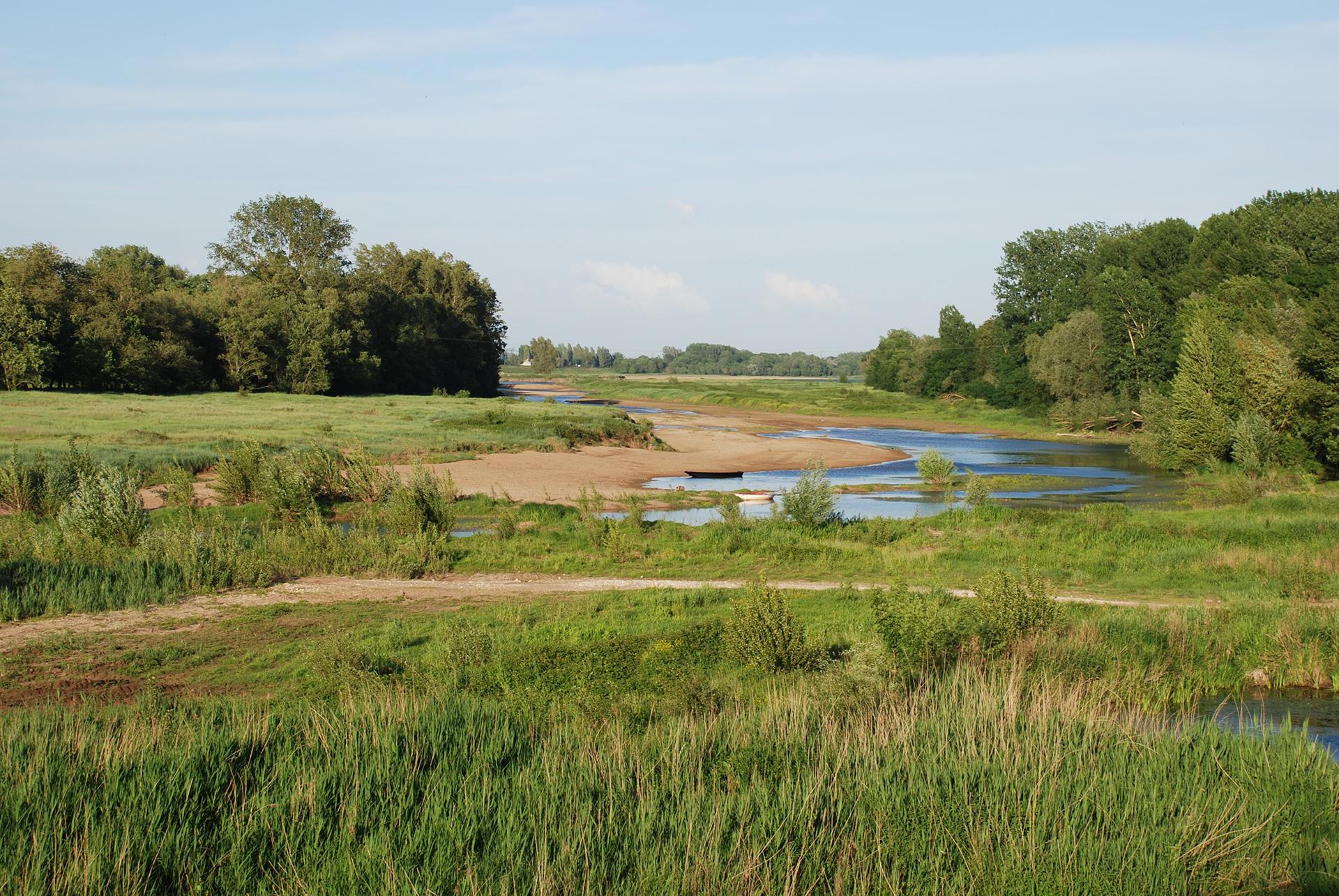
State of groundwater: monitoring by BRGM
Groundwater is a widely used resource: in metropolitan France, it accounts for nearly two-thirds of drinking water consumption and more than one-third of agricultural water consumption. It is also widely used in the industrial sector. Groundwater tables depend on cyclical recharges.
BRGM monitors groundwater levels and quality in mainland France. Discover the actions carried out by the French geological survey and the resources and databases available on groundwater in France.
Press contact


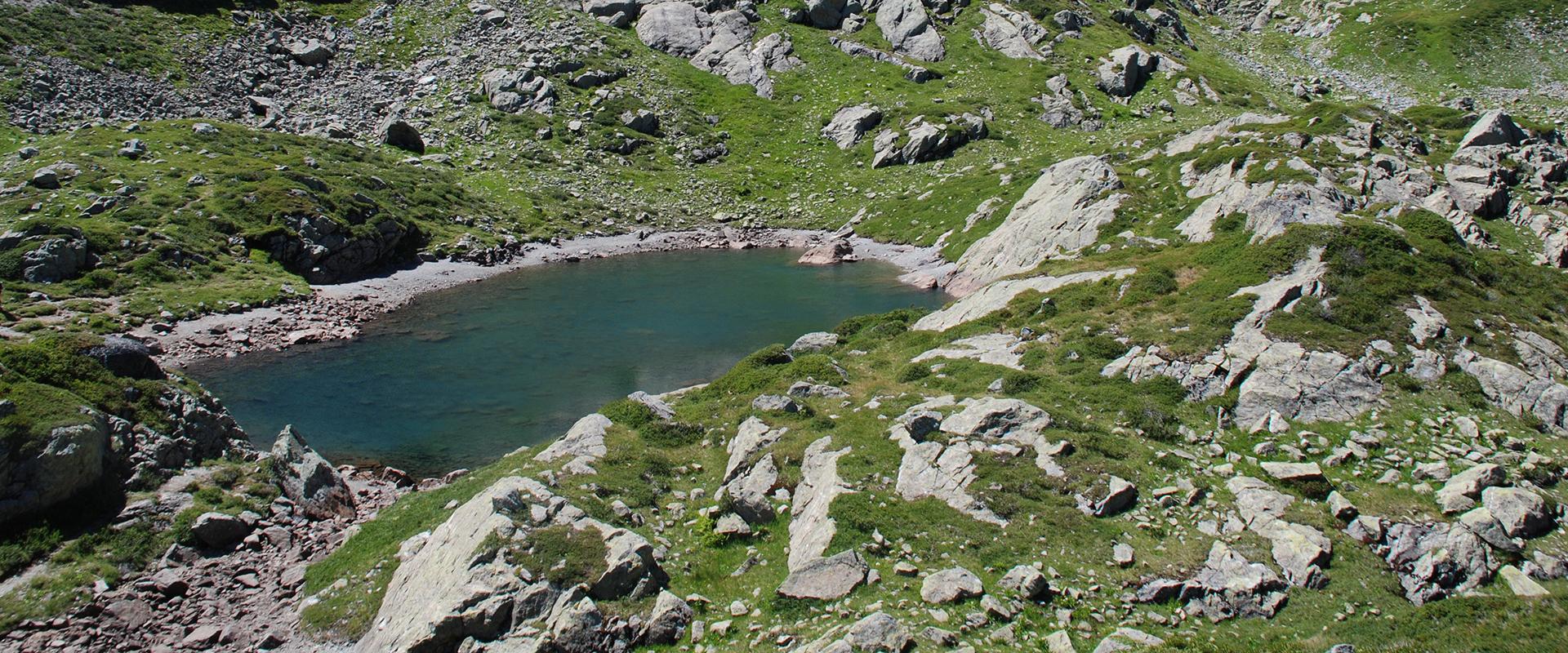
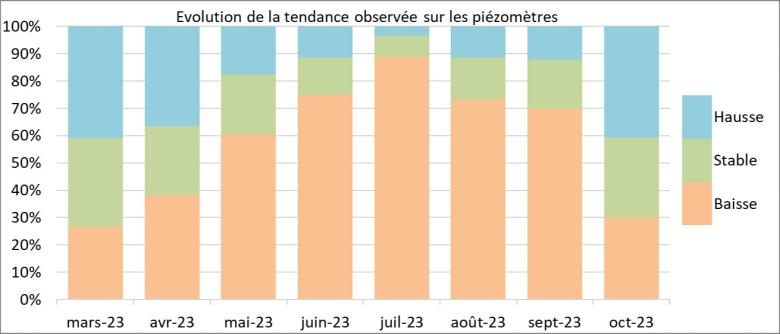
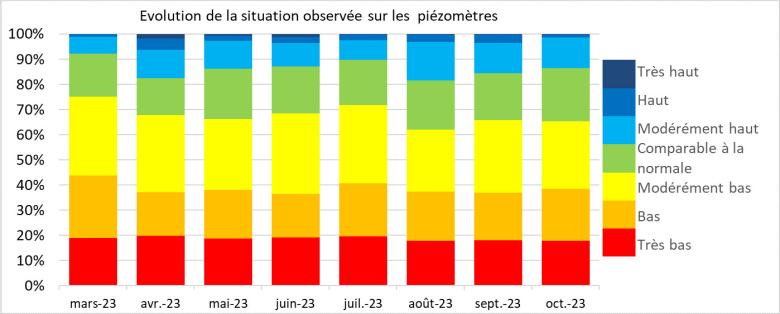




Map drawn up by BRGM on 10 November 2023, based on data from the ADES database, acquired up to 31 October 2023. Data source: ADES database (ades.eaufrance.fr) / Hydroportail (hydro.eaufrance.fr) / Background map © IGN. Data producers and contributors: APRONA, BRGM, Conseil Départemental de la Vendée, Conseil Départemental des Landes, Conseil Départemental du Lot, EPTB Vistre Vistrenque, Parc Naturel Régional des Grandes Causses, Syndicat Mixte d'Etudes et de Travaux de l'Astien (SMETA), Syndicat Mixte pour la protection et la gestion des nappes souterraines de la plaine du Roussillon (SMNPR).
This map shows the global indicators reflecting the average fluctuations of the aquifers. They are based on point indicators collected at groundwater monitoring points (by means of piezometers).
The "Aquifer levels" indicator compares the current month’s figures with those of the same months in the entire record, i.e. at least 15 years of data and sometimes up to as much as 100 years of data. It is divided into 7 classes, from the lowest level (in red) to the highest (in dark blue).
The grey areas correspond to areas without unconfined aquifers, i.e. with an impermeable or semi-permeable layer above the aquifer, and/or sectors with a very low density of measuring points. This last case primarily concerns mountainous areas with small, heterogeneous aquifers.
The "Evolution of levels" indicator reflects the variation of the water level of the past month compared to the two previous months (stable, increasing or decreasing).
These global indicators reflect general situations and trends and do not take into account possible local disparities.